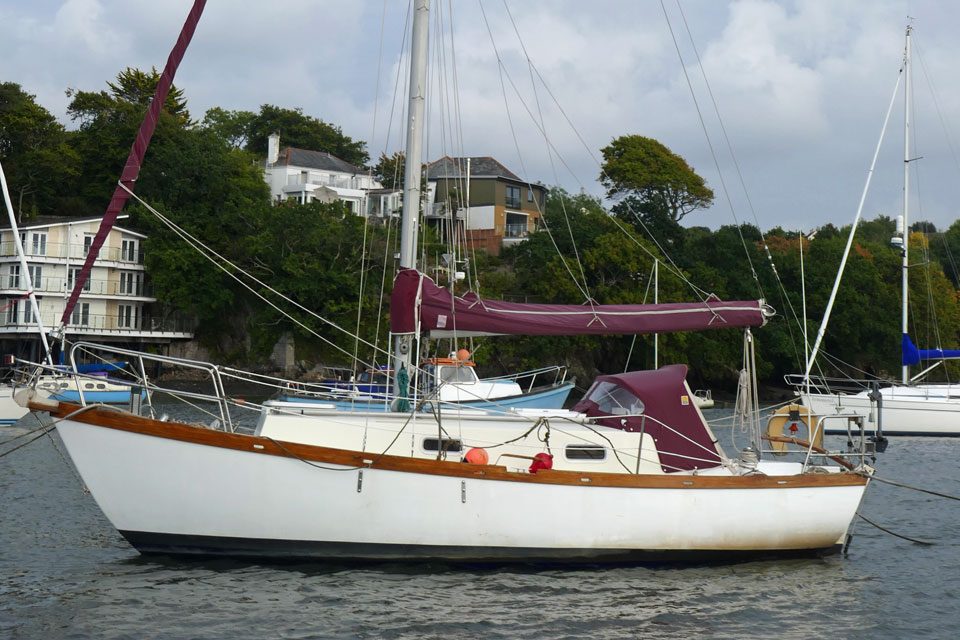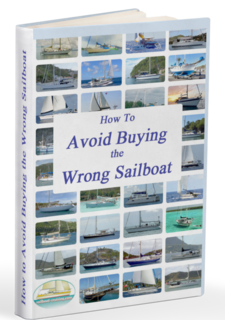- Home
- Cruiser Yachts under 30'
- Vertue
The Vertue 25 Sailboat
Specs & Key Performance Indicators
The Vertue 25, a heavy-displacement long-keeled sloop, was designed by Jack Laurent Giles and built in the UK by E.F.Elkins Ltd.
 A Vertue II
A Vertue IIPublished Specification for the Vertue 25
Underwater Profile: Long keel with transom-hung rudder
Hull Material: Various*
Length Overall: 25'3" (7.7m)
Waterline Length: 21'6" (6.6m)
Beam: 7'2" (2.2m)
Draft: 4'6" (1.4m)
Rig Type: Masthead sloop
Displacement: 11,000lb (4,990kg)
Designer: Jack Laurent Giles
Builder: E F Elkins Ltd (UK)
Year First Built: 1947
Number Built: 270
* 230 in wood, wood/epoxy or steel, plus 40 in GRP.
Published Design Ratios for the Vertue 25
1. Sail Area/Displacement Ratio: 9.7
2. Ballast/Displacement Ratio: 40.9
3. Displacement/Length Ratio: 494
4. Comfort Ratio: 54.6
5. Capsize Screening Formula: 1.3
Summary Analysis of the Design Ratios for the Vertue 25
1. A Sail Area/Displacement Ratio of just 9.7 suggests that the Vertue 25 will need a stiff breeze to get her going. In light conditions, unless you've got plenty of time on your hands, motor-sailing may be the way to go.
2. A Ballast/Displacement Ratio of 40.9 means that the Vertue 25 will stand up well to her canvas in a blow, helping her to power through the waves.
3. A Displacement/Length Ratio of 494, tells us the Vertue 25 is firmly in the ultra-heavy displacement category. Load her up as much as you like and her performance will be hardly affected, not that it was ever startling. Few if any sailboats are built to this displacement category these days - but they remain popular with some long-distance sailors.
4. Ted Brewer's Comfort Ratio of 54.6 suggests that crew comfort of a Vertue 25 in a seaway is similar to what you would associate with the motion of an extremely heavy bluewater boat - and that's as comfortable as life ever gets on a sailing boat!
5. The Capsize Screening Formula (CSF) of 1.3 indicates that a Vertue 25 would be a safer choice of sailboat for an ocean passage than one with a CSF of more than 2.0.
Cruisers' Questions about this Sailboat...
What is the history of Vertue 25 sailboat?
What is the history of Vertue 25 sailboat?
The history of the Vertue 25 sailboat is quite fascinating. It dates back to 1936, when the first boat of this design, named ANDRILLOT, was launched by Jack Laurent Giles for Humphrey Barton. The design was not named Vertue until after the war, when another boat of this design, named EPENETA, won the Little Ship Club's Vertue Cup in 1939 for a passage across the Bay of Biscay. The Vertue Cup is given for the best log of a cruise longer than a week by a member of the club.
The Vertue 25 sailboat gained an enviable reputation as a long-distance cruiser, with several remarkable voyages completed by boats of this class and close derivatives, such as Vertue XXXV, which sailed from England to New York in 1950. The design has also been praised by famous sailors such as Eric and Susan Hiscock.
There have been minor variants of the design, most notably in the shape of the coach-roof and the hull material. The original design had a length overall of 25'3" (7.7m), a beam of 7'2" (2.2m) and a draft of 4'6" (1.4m). The extended cruising version of the design was known as the Vertue Ocean and incorporated modifications suggested by Barton. The Vertue II design is slightly larger at 25'8" (7.8m) overall with a 7'10" (2.4m) beam and has been produced in GRP since the 1970s by Bossoms Boatyard in Oxford.
What are some famous voyages completed by Vertue 25 sailboats?
What are some famous voyages completed by Vertue 25 sailboats?
Some of the famous voyages completed by Vertue 25 sailboats are:
- In 1950, Humphrey Barton sailed from England to New York in Vertue XXXV, a 25'3" wooden sloop, in 40 days. This was the first transatlantic crossing by a small yacht and inspired many other sailors to follow his example.
- In 1952, Eric and Susan Hiscock sailed around the world in Wanderer III, a 30' wooden sloop based on the Vertue design. They covered 30,000 miles in three years and wrote several books about their adventure.
- In 1966, David Lewis sailed from England to New Zealand in Rehu Moana, a 25'8" GRP sloop of the Vertue II design. He then continued to sail around the Pacific islands and Antarctica for several years.
- In 1979, John Guzzwell sailed around the world in Trekka, a 20'9" wooden sloop derived from the Vertue design. He covered 28,000 miles in four years and became the youngest person to circumnavigate the globe single-handed at the time.
- In 1990, ELLENOR JOSEPHINE, a 25'8" GRP sloop of the Vertue Ocean design, was launched by IBTC Lowestoft for Ian Wright, who wanted to sail long distances. She has since been sold to different owners and has cruised around the UK and Europe.
What are some modifications that have been made to the Vertue 25 sailboat over time?
What are some modifications that have been made to the Vertue 25 sailboat over time?
Some of the modifications that have been made to the Vertue 25 sailboat over time are:
- After winning the Vertue Cup in 1939, Laurent Giles named the class the Vertue and made minor modifications to the hull and coachroof design. These Vertues became the classic small boat of choice for the single-handed long distance sailor.
- The extended cruising version of the design was known as the Vertue Ocean and incorporated modifications suggested by Humphrey Barton, such as additional freeboard, a slightly different sheer, a longer bowsprit, a larger cockpit and a self-draining well.
- The Vertue II design is slightly larger at 25'8" (7.8m) overall with a 7'10" (2.4m) beam and has been produced in GRP since the 1970s by Bossoms Boatyard in Oxford. It also has a different coachroof shape, a longer waterline length, a shorter boom and a higher aspect ratio rig.
- Some individual owners have also made their own modifications to their Vertues, such as changing the engine, adding or removing equipment, altering the interior layout, or repainting the hull.
The above answers were drafted by sailboat-cruising.com using GPT-4 (OpenAI’s large-scale language-generation model) as a research assistant to develop source material; to the best of our knowledge, we believe them to be accurate.
Recent Articles
-
Hans Christian 43: Classic Bluewater Cruiser & Liveaboard Sailboat
Dec 10, 25 04:37 AM
Explore the Hans Christian 43: a legendary heavy-displacement, long-keel sailboat. Read our in-depth review of its specs, design ratios, and suitability for offshore cruising and living aboard. -
Planning Your Sailboat Liveaboard Lifestyle: An Ocean Sailor's Guide
Dec 06, 25 05:18 AM
Seasoned sailors share their methodical risk analysis for planning a secure Sailboat Liveaboard Lifestyle, covering financial, property, and relationship risks. -
Marine Cabin Heaters: The Expert’s Guide to Comfort & Safety at Sea
Dec 05, 25 06:52 AM
Choose the best Marine Cabin Heaters for your vessel. Expert advice on diesel, paraffin, and hot water systems for year-round cruising comfort.













